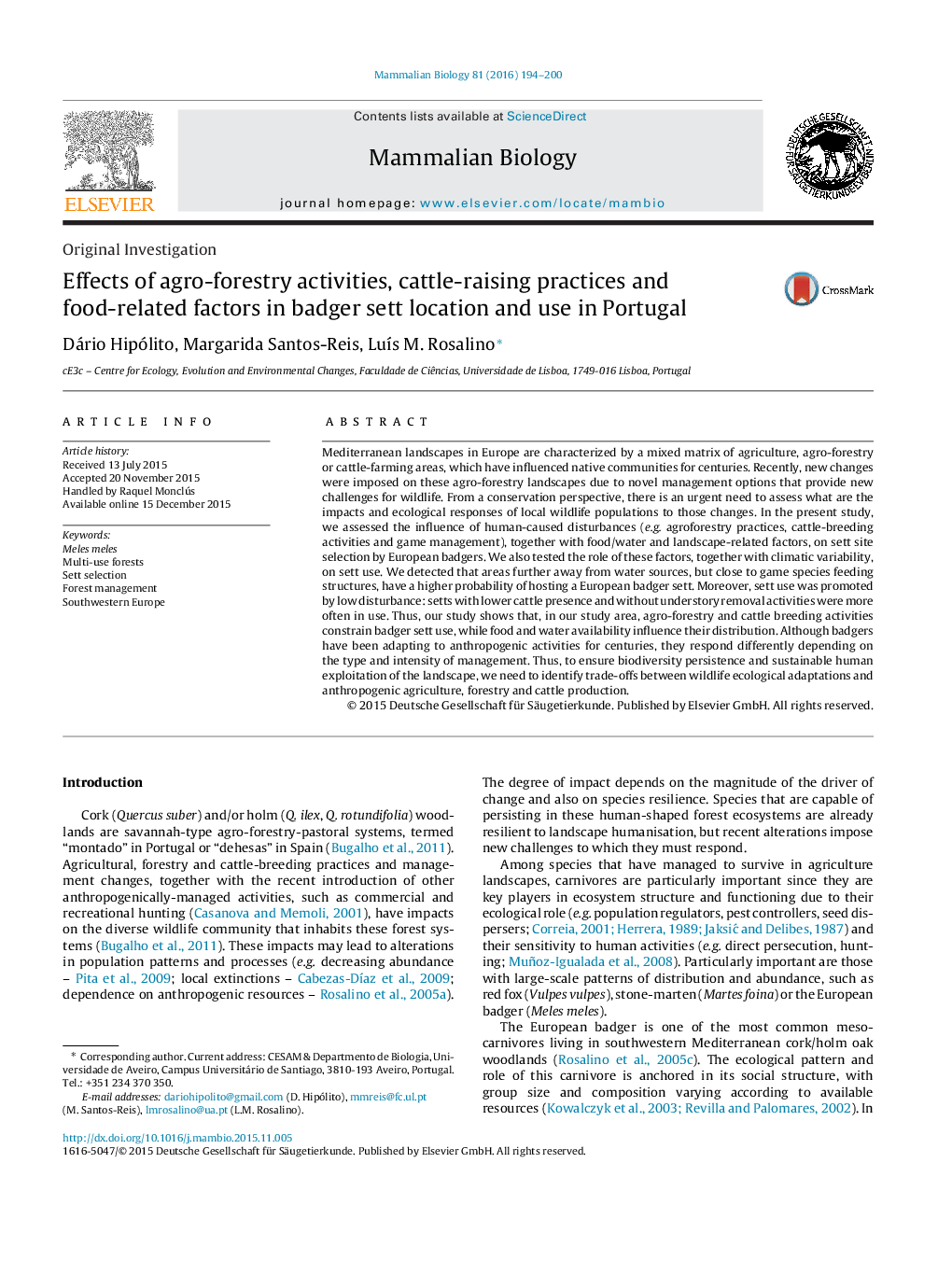| کد مقاله | کد نشریه | سال انتشار | مقاله انگلیسی | نسخه تمام متن |
|---|---|---|---|---|
| 2193324 | 1098369 | 2016 | 7 صفحه PDF | دانلود رایگان |
عنوان انگلیسی مقاله ISI
Effects of agro-forestry activities, cattle-raising practices and food-related factors in badger sett location and use in Portugal
ترجمه فارسی عنوان
تأثیر فعالیت های جنگلداری، شیوه های گاوداری و عوامل مربوط به غذا در موقعیت و استفاده از پرچم سرنشین در پرتغال
دانلود مقاله + سفارش ترجمه
دانلود مقاله ISI انگلیسی
رایگان برای ایرانیان
ترجمه چکیده
مناظر مدیترانه ای در اروپا با یک ماتریس مخلوط از زمین های کشاورزی، جنگلداری و دامداری مشخص می شود که طی قرن ها بر جوامع بومی تأثیر گذاشته اند. به تازگی، تغییرات جدید در این مناظر کشاورزی و جنگل به دلیل گزینه های مدیریتی جدید ارائه شده است که چالش های جدیدی را برای حیات وحش فراهم می کند. از دیدگاه حفاظت، نیاز فوری به ارزیابی اثرات و پاسخ های اکولوژیکی جمعیت های محلی حیات وحش به این تغییرات وجود دارد. در مطالعه حاضر، ما در تأثیر اختلالات ناشی از انسان (مثلا شیوه های جنگل زراعی، فعالیت های پرورش دام و مدیریت بازی)، و همچنین عوامل مرتبط با غذا / آب و چشم انداز، در انتخاب گاوهای گوشتی اروپا مورد بررسی قرار گرفتیم. ما همچنین نقش این عوامل را، همراه با تنوع زیست محیطی، در استفاده از استحکام تست کردیم. ما متوجه شدیم که مناطق دورتر از منابع آب، اما نزدیک به ساختارهای تغذیه گونه های بازی، احتمال بیشتری برای میزبانی یک قلاب ماهیگیر اروپایی وجود دارد. علاوه بر این، استفاده از استحکامات با اختلال کم تحرک ایجاد شد: با وجود حضور کمتری گاوها و فعالیت های حذف کودی بیشتر، استفاده شد. بنابراین، مطالعه ما نشان می دهد که در منطقه مطالعه ما فعالیت های کشت و زراعی و جنگلداری محدود کردن استفاده از ماهیان باربری است، در حالی که دسترسی به غذا و آب بر توزیع آنها تاثیر می گذارد. گرچه بذورها برای قرن ها سازگار با فعالیت های انسان شناسی هستند، آنها بسته به نوع و شدت مدیریت، متفاوت عمل می کنند. بنابراین، برای اطمینان از پایداری تنوع زیستی و بهره برداری پایدار انسان از چشم انداز، ما باید شناسایی ترکیبات سازگاری زیست محیطی حیات وحش و کشاورزی، جنگلداری و تولید گاو های انسانی را شناسایی کنیم.
موضوعات مرتبط
علوم زیستی و بیوفناوری
علوم کشاورزی و بیولوژیک
علوم دامی و جانورشناسی
چکیده انگلیسی
Mediterranean landscapes in Europe are characterized by a mixed matrix of agriculture, agro-forestry or cattle-farming areas, which have influenced native communities for centuries. Recently, new changes were imposed on these agro-forestry landscapes due to novel management options that provide new challenges for wildlife. From a conservation perspective, there is an urgent need to assess what are the impacts and ecological responses of local wildlife populations to those changes. In the present study, we assessed the influence of human-caused disturbances (e.g. agroforestry practices, cattle-breeding activities and game management), together with food/water and landscape-related factors, on sett site selection by European badgers. We also tested the role of these factors, together with climatic variability, on sett use. We detected that areas further away from water sources, but close to game species feeding structures, have a higher probability of hosting a European badger sett. Moreover, sett use was promoted by low disturbance: setts with lower cattle presence and without understory removal activities were more often in use. Thus, our study shows that, in our study area, agro-forestry and cattle breeding activities constrain badger sett use, while food and water availability influence their distribution. Although badgers have been adapting to anthropogenic activities for centuries, they respond differently depending on the type and intensity of management. Thus, to ensure biodiversity persistence and sustainable human exploitation of the landscape, we need to identify trade-offs between wildlife ecological adaptations and anthropogenic agriculture, forestry and cattle production.
ناشر
Database: Elsevier - ScienceDirect (ساینس دایرکت)
Journal: Mammalian Biology - Zeitschrift für Säugetierkunde - Volume 81, Issue 2, March 2016, Pages 194-200
Journal: Mammalian Biology - Zeitschrift für Säugetierkunde - Volume 81, Issue 2, March 2016, Pages 194-200
نویسندگان
Dário Hipólito, Margarida Santos-Reis, LuÃs M. Rosalino,
